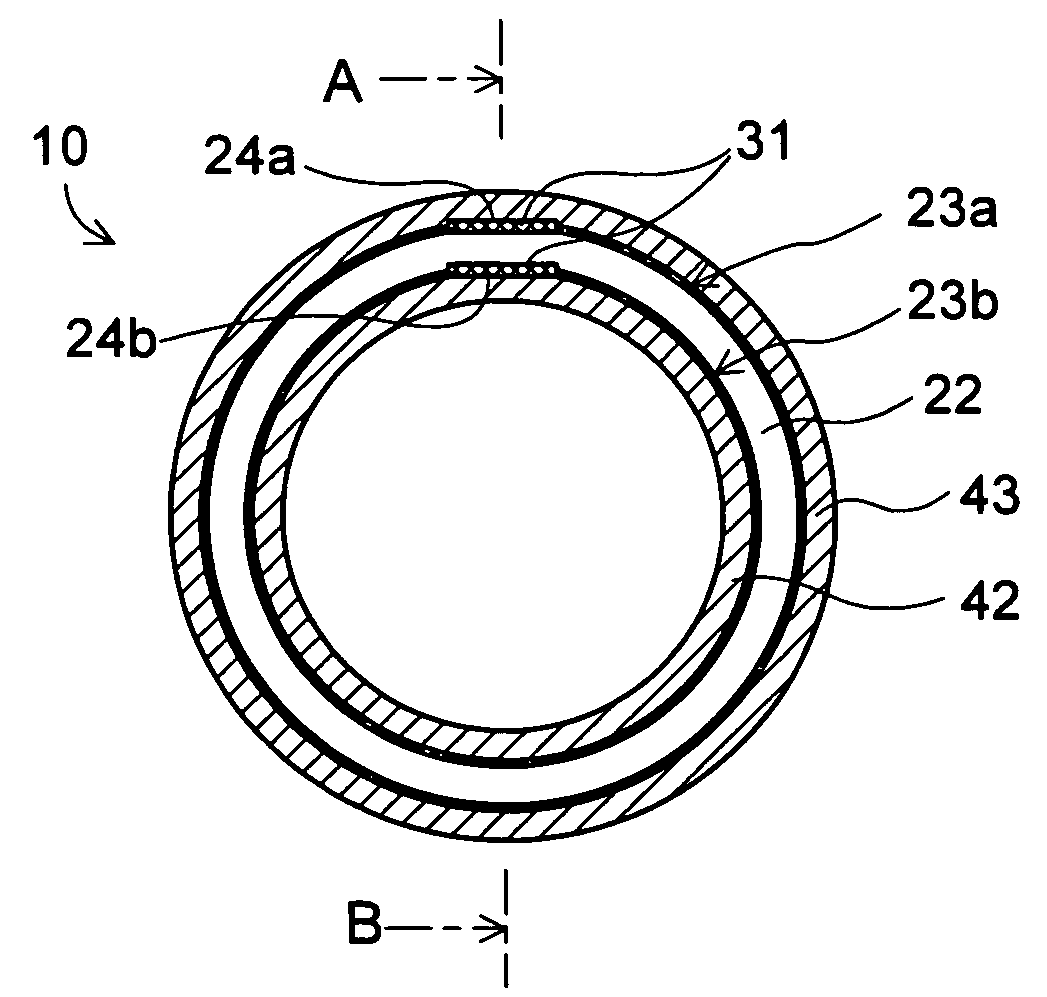[0011]The present invention has been made to solve the foregoing problems, and an object of the present invention is to provide a thermoelectric conversion module enabling cost reduction by reducing the number of parts, making the
assembly procedure simpler, reducing time and work required for
assembly, and so on.Means for Solving the Problems
[0014]A In accordance with the invention in the first aspect, a doubled cylindrical support unit consisting of an electrically insulated inner tube that internally touches the tubular element unit and whose outer circumference surface supports the tubular element unit and an electrically insulated outer tube that externally touches the tubular element unit and whose inner circumference surface supports the tubular element unit is provided. Accordingly, the thermoelectric conversion module according to the present invention can be assembled easily in comparison to a conventional thermoelectric conversion module in which a plurality of thermoelectric elements needed to be arranged in a rotation symmetric form between an inner tube and an outer tube since it has a simple structure in which the tubular element unit is supported by the inner tube and the outer tube. Thus, it is possible to reduce time and work required for assembly and enable cost reduction.
[0017]The above inner tube and outer tube may have a function of limiting movement of fluid substances such as gas, liquid, particles, etc. residing on the inner circumference surface side and outer circumference surface side of the above thermoelectric conversion module. Also, the above inner tube and outer tube can have a function of making the temperature of the inner circumference
surface electrode and the outer circumference
surface electrode of each thermoelectric element in the above thermoelectric conversion module relatively constant within each
electrode. Further, the above inner tube and outer tube can have a structure that enables efficient
heat transfer from various kinds of fluid substances such as gas, liquid, particles, etc. moving nearby. For example,
macro- or micro-fins or the likes can be attached.
[0018]Also, other than the above inner tube and outer tube, a heat blocking member having the above functions can be provided. This heat blocking member can include a heat blocking body such as, for example, the above inner tube and / or outer tube. The heat blocking body can include, for example, an insulated ring body to be inserted between the plurality of ring-like thermoelectric elements. Such a ring body can electrically insulate respective ring-like thermoelectric elements in an axis direction along the center axis of the plurality of ring-like thermoelectric elements. Such a ring body can maintain a mutual appropriate space between the plurality of ring-like thermoelectric elements and can function as a structure auxiliary member that can maintain the structure of the entire thermoelectric conversion module.
[0021]In accordance with the second and the third aspects of the present invention, the plurality of ring-like thermoelectric elements have been obtained by
processing the sintered body made of entirely the same kind of components. Thus, the thermoelectric conversion module is assembled using the thermoelectric elements obtained by
processing the sintered body made of the same kind of components. Accordingly, since it is not necessary to check whether or not the arranging order is correct in comparison to a conventional case in which two kinds of different thermoelectric elements are arranged alternately to assemble a thermoelectric conversion module, it is possible to reduce time and work required for assembly. Also, according to the present invention, the thermoelectric elements of the same kind only need to be purchased, and thus the purchase
unit cost can be lowered more than in the case of
purchasing two kinds of different thermoelectric elements as in the conventional case, which enables cost reduction.
[0024]According to the present invention, a doubled cylindrical support unit consisting of an electrically insulated inner tube that internally touches the tubular element unit and whose outer circumference surface supports the tubular element unit and an electrically insulated outer tube that externally touches the tubular element unit and whose inner circumference surface supports the tubular element unit is provided. Accordingly, the thermoelectric conversion module according to the present invention can be assembled easily in comparison to a conventional thermoelectric conversion module in which a plurality of thermoelectric elements needed to be arranged in a rotation symmetric form between an inner tube and an outer tube since it has a simple structure in which the tubular element unit is supported by the inner tube and the outer tube. Thus, it is possible to reduce time and work required for assembly and enable cost reduction.
 Login to View More
Login to View More  Login to View More
Login to View More 


